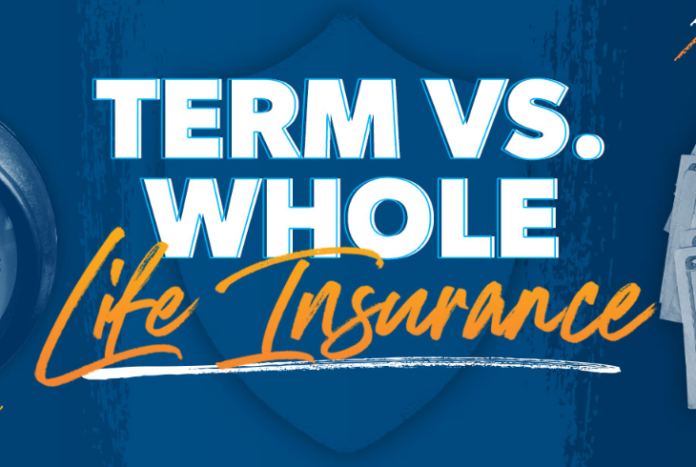Wondering which option to go with? Will it be Term or Whole Life Insurance? Life is full of uncertainties, but one thing is for sure: we all want to leave a legacy and ensure our loved ones are financially secure if we’re gone. That is where life insurance steps in, offering a powerful tool for peace of mind.
However, with different types of life insurance available, choosing the right one can feel like navigating a financial maze. Today, we will shed light on the two most common options: term life insurance and whole life insurance. Buckle up, because understanding these two can be a game-changer for your financial planning!
Term Life Insurance: Affordable Protection for a Specific Period
Term life insurance offers a powerful shield for a specific period, protecting your loved ones financially if the unexpected happens. It shines in affordability and simplicity, making it a popular choice for many. Let’s delve deeper and explore why term life insurance might be the key to your financial security strategy.
The Power of Affordability:
One of the most attractive aspects of term life insurance is its budget-friendly nature. Here’s how it works:
- Age Matters: Generally, the younger and healthier you are at the time of application, the lower your premium will be. This makes it ideal for young adults starting families or individuals entering their prime earning years.
- No Cash Value: Unlike whole life insurance, term life doesn’t have a cash value component. You simply pay your premium, and if you pass away during the term, your beneficiaries receive the death benefit. This eliminates the need for investment and keeps your costs down.
- Flexibility with Term Length: Term policies come in various lengths, typically ranging from 10 to 30 years. You can choose a term that aligns with your specific needs, such as the duration of your mortgage or your child’s dependent years.
Beyond Affordability: The Benefits of Term Life
While affordability is a major draw, term life insurance offers more than just a good price tag:
- Peace of Mind: Knowing your loved ones will have a financial cushion in your absence is a priceless benefit. They can use the death benefit to pay off debts, maintain their standard of living, or fund education.
- Focus on Specific Needs: Term life allows you to target specific financial needs. For example, if your primary concern is replacing your income while your children are young, you can choose a 20-year term that aligns with their college years.
- Renewable and Convertible (Sometimes): Some term life policies offer the option to renew them at the end of the term, although the premiums will likely increase due to your older age. Additionally, certain policies allow you to convert your term coverage to whole life insurance later on, providing flexibility if your needs change.
Who Can Benefit most from Term Life?
- Young families: Term life fills the gap if a parent passes away prematurely, ensuring financial stability during a critical time.
- Income earners: With a death benefit, the surviving family can cover important expenses like mortgages, childcare, or education costs.
- Individuals with outstanding debt: Term life ensures your loved ones won’t inherit your financial burdens like student loans or credit card debt.
Term life insurance is not a one-size-fits-all solution. While it boasts affordability and targeted protection, it doesn’t offer lifelong coverage or a cash value component.
Term life insurance is a valuable tool for anyone seeking affordable protection during a specific period. It provides peace of mind, allowing you to focus on building your future while knowing your loved ones will be taken care of in case of your untimely passing. If you prioritize affordability and need coverage for a defined period, then term life insurance might be your champion.
Whole Life Insurance: Lifelong Coverage with a Savings Bonus
Whole life insurance goes beyond simply providing a death benefit. It’s a comprehensive package that offers lifelong coverage and a built-in savings component, making it an attractive option for those seeking long-term security and financial flexibility. Let’s explore the unique features of whole life insurance and how it can benefit your financial future.
Guaranteed Coverage for Life:
Unlike term life, whole life insurance doesn’t have an expiration date. As long as you pay your premiums, your beneficiaries will receive a death benefit whenever you pass away. This provides a sense of security and ensures your loved ones are financially protected, regardless of your age at the time of death.
The Power of Cash Value:
This is where whole life truly sets itself apart. A portion of your premium goes towards building a cash value within your policy. This cash value grows over time, typically at a guaranteed interest rate, offering a savings element alongside the death benefit.
Accessing Your Cash (with Limitations):
The beauty of whole life is the flexibility it offers regarding your cash value. Here are some ways you can access your accumulated funds:
- Policy Loans: You can borrow against your cash value, typically with interest, for emergencies, investments, or major purchases. This allows you to tap into your savings without withdrawing the entire amount.
- Withdrawals: While less common, some policies may allow you to withdraw a portion of your cash value, potentially subject to tax implications.
- Dividends (Mutual Companies): If you purchase a whole life policy from a mutual insurance company, you may be eligible to receive dividends. These are a share of the company’s profits, which can be reinvested in your policy to further increase your cash value.
Whole Life: A Long-Term Play
While it offers undeniable benefits, whole life insurance is a long-term commitment. Here are some key points to consider:
- Higher Premiums: Compared to term life, whole life premiums are significantly higher due to the added savings component. This may not be ideal for everyone’s budget.
- Slower Growth: The guaranteed interest rate on the cash value might be lower than what you could potentially earn through other investment options. However, it offers stability and avoids market fluctuations.
- Long-Term Focus: Whole life shines when viewed as a long-term strategy. The cash value has time to accumulate, potentially becoming a valuable asset for retirement or future needs.
Who Can Benefit most from Whole Life?
- Estate Planning: If you want to leave a financial legacy for your loved ones, the cash value in your whole life policy can be a significant contribution.
- Retirement Planning: The accumulated cash value can supplement your retirement income and provide additional financial security.
- Financial Flexibility: The ability to access your cash value through loans or withdrawals can be helpful for unexpected expenses or investment opportunities.
Whole life insurance offers a comprehensive package of lifelong coverage, guaranteed cash value growth, and some level of access to your accumulated funds. However, it comes at a higher premium cost and may not be the fastest path to wealth accumulation.
Weigh the long-term benefits against your budget and financial goals to determine if whole life is the right fit for you.
Making your Choice: Term vs. Whole Life
Now that you’ve explored the strengths and weaknesses of both term and whole life insurance, it’s time to decide which champion best suits your financial goals. Here’s a roadmap to guide you through the decision-making process:
Step 1: Assess Your Needs
- Coverage Duration: How long do you need financial protection for your loved ones?
- Financial Goals: Are you primarily focused on replacing income, covering debts, or building long-term wealth?
- Budget: How much can you comfortably afford in monthly premiums?
Step 2: Weigh Your Options
Term Life:
- Pros: Affordable, targeted protection for a specific period, flexible term lengths, good for young families or income replacement.
- Cons: No cash value, coverage ends after the term, premiums may increase if you renew.
Whole Life:
- Pros: Lifelong coverage, guaranteed cash value growth, some access to cash through loans or withdrawals, potential for estate planning or retirement income supplement.
- Cons: Higher premiums than term life, slower cash value growth compared to some investments, long-term commitment.
Step 3: Consider Your Life Stage
- Young Adults/Starting a Family: Term life might be ideal due to its affordability while you build your career and family.
- Mid-Career/Established Family: You could consider either option, depending on your need for long-term coverage and cash value growth.
- Approaching Retirement: Whole life could be a good choice if you’ve built up cash value and seek a source of retirement income.
Step 4: Don’t Ignore Your Risk Tolerance
- Term Life: Offers peace of mind with a lower financial risk (premiums) upfront.
- Whole Life: Requires a higher upfront commitment (premiums) but offers the potential for long-term growth and flexibility.
Additional Considerations:
- Health: If you have pre-existing health conditions, whole life premiums may be even higher.
- Lifestyle: Consider any potential changes in your income or financial needs over time.
- Financial Advisor: Consulting a qualified advisor can help you create a personalized life insurance plan based on your specific circumstances.
By understanding your needs, financial goals, and risk tolerance, you can make an informed decision about whether term or whole life insurance is the right champion for your financial security journey.
Conclusion
Ultimately, the best choice depends on your individual circumstances, financial goals, and risk tolerance. Consider factors like your age, income, dependents, and long-term financial plans. Consulting a qualified financial advisor can help you navigate the complexities of term and whole life insurance and choose the champion that best protects your future and your loved ones.
Don’t be afraid to shop around and compare quotes from different insurance companies to find the best fit for your budget and needs. By taking the time to understand term and whole life insurance, you’ll be well on your way to securing a brighter future for yourself and your loved ones.












